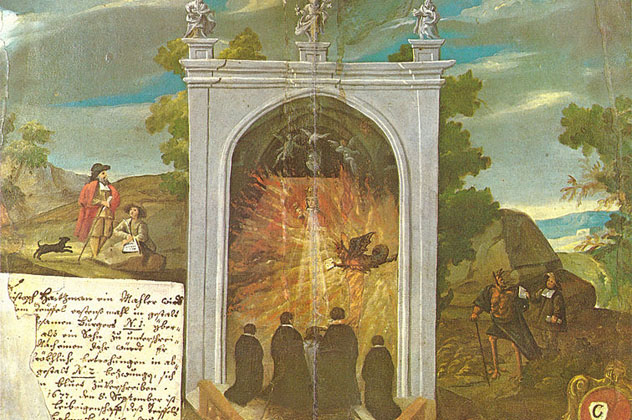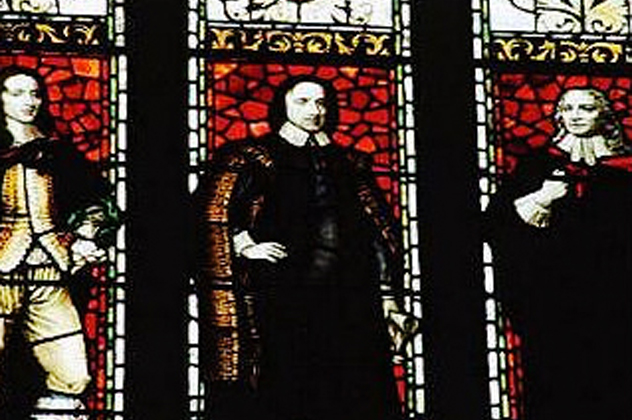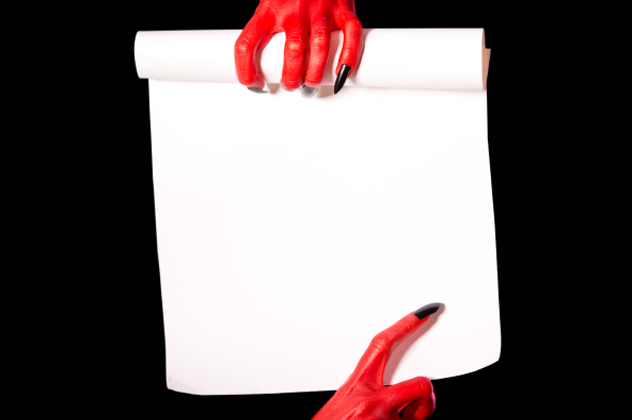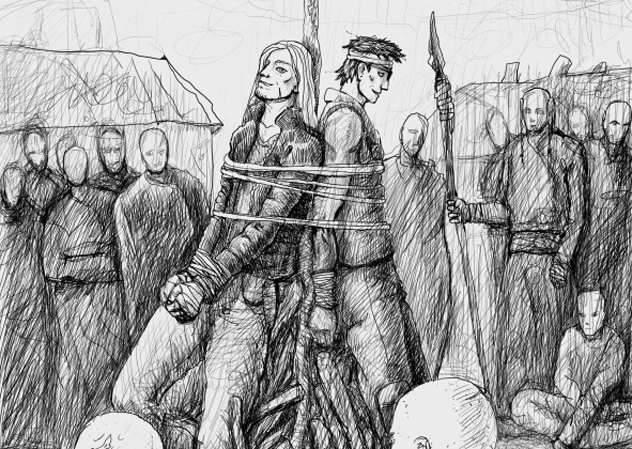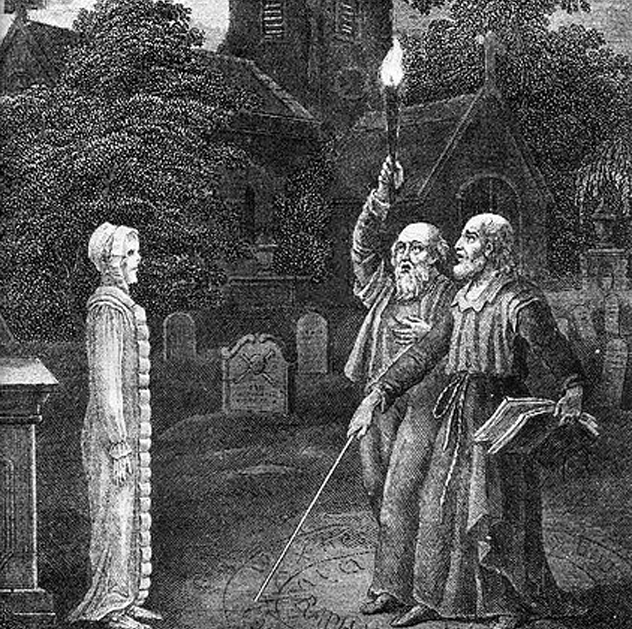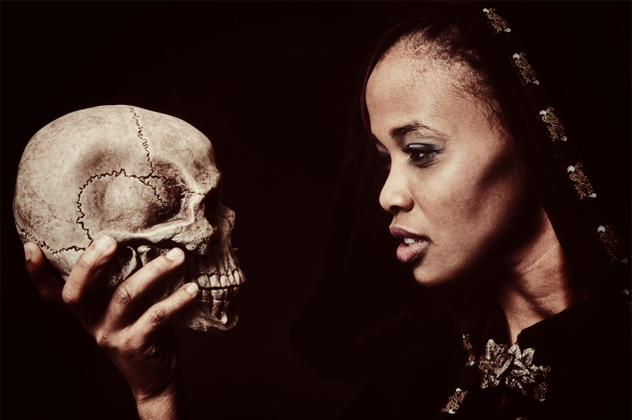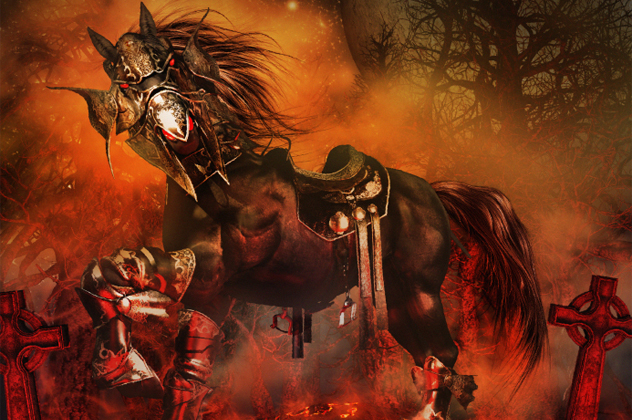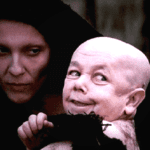10Christoph Haizmann
A painter working in Bavaria and Austria in the late 17th century, Chistoph Haizmann was at the center of a bizarre witch hunt and pact with the Devil. When he collapsed on August 29, 1677, he showed all the signs of being tortured by a witch’s curse. When questioned by authorities, Haizmann claimed that it was his own fault and that he’d signed a pact with the Devil nine years earlier as a way out of the cycle of poverty and depression that had become his life. He had agreed to be the Devil’s physical son on Earth, but he also claimed that he’d rejected the otherworldly demon’s offers of riches and mystical texts. When a local Catholic priest named Leopold Braun heard about the painter’s story, he recruited the help of exorcists from the Abbey of Mariazell. After a few exorcisms, Haizmann had a vision of the Devil in which the beast appeared to him in the form of a massive dragon. The dragon was carrying a copy of the contract he’d written and signed, and Haizmann claimed that he was able to grab the document and tear it up. Afterward, Haizmann’s symptoms seemed to disappear. He continued to paint, and the Devil featured in most of his works. In every consecutive one, his depiction of the Devil became more twisted and hideous, and Haizmann’s symptoms of possession began reoccurring after he went to live with his sister and her husband. He also joined the Brotherhood of the Holy Cross. Haizmann continued to write some pretty terrifying stuff about the battle for his soul. According to his journals, the Devil appeared to him frequently, trying to tempt him with all the worldly pleasures you could imagine. Angels came to him, too, trying to persuade him to lead a penitent life. After going through another set of exorcisms at Mariazell, the symptoms once again passed. Haizmann took the name Brother Chrysostom and spent the rest of his life deep in a religious life. Haizmann’s story might have been completely forgotten if he wasn’t the subject of a paper by Sigmund Freud. Freud claimed—in typical Freudian style—that Satan represented Haizmann’s recently deceased father. The painter was torn by feelings of depression over his death and hatred for the man, and the Devil in turn represented a need for someone to keep him safe. A more contemporary diagnosis of Haizmann’s condition is that he was likely suffering from schizophrenia.
9Paulo Gil
The Devil was alive and well in colonial-era Brazil, and the journals of a freedman named Joao Batista tell the story of a local sorcerer called Paulo Gil. According to Batista, Gil was a well-known sorcerer who sold his soul to the Devil for some deadly powers. Among his first victims was a slave that Gil had taken a liking to. The slave owner disapproved of any possible relationship, and the slave remained just out of Gil’s reach. It wasn’t long before both required exorcisms thanks to the influence of Gil’s demons. Batista recounts how Gil approached him, offered him a “mandinga pouch,” and promised that it would keep him safe. Batista declined, knowing of Gil’s demonic influences. Yet, Gil was persistent and eventually convinced him to accompany him on a nighttime trip. They ended up at a crossroads, and after Gil stepped away for only a moment, he returned with seven shadowy figures. Batista fled, and a few days later he found himself in incredible pain. When he confronted Gil, the sorcerer said that he had injured him, stealing some of his blood and giving it to his demonic friends. When Batista again refused an offer to get involved in Gil’s evil occupations, an otherworldly storm descended on the village. It only left when Batista prayed to St. Anne, denying Gil and the demons his blood. The story has elements that are common in what were traditional tales in Brazil: the story of Devil worship among the colony’s slaves. Gil was a typical sorcerer, working his magic at a crossroads at night, taking blood, and siphoning life from a person’s hip, with his dark masters causing a storm when they were denied. St. Anne was traditional, too, an increasingly popular saint for the devout to appeal to.
8Antoine Rose
In 1477, a witch named Antoine Rose was put on trial. Known as the Witch of Savoy, she told a very specific story that would help cement one of the most iconic images that still goes along with witchcraft: the broom. According to Rose’s testimony, she had been in need of money when she approached her neighbor with her problems. Fortunately, that neighbor knew a guy . . . and he introduced her to a group of people that persuaded her to appeal to the Devil for aid. The Devil appeared in the form of a man named Robinet. He promised her all the money that she needed as long as she would renounce God and pay homage to him. She also agreed with his demand to pay him a certain percentage of her earnings every year. In return, he gave her a bag of gold and silver, a stick, and a jar filled with ointment, plus instructions on how to use it to return to the place she met him. All she needed to do was rub the stick with the ointment, mount said stick, and say, “Go, in the Devil’s name, go!” Rose testified that the homage they paid to the Devil involved things like dancing and feasting, stepping on the consecrated host, and kissing the Devil’s hindquarters when he shifted into the form of a black dog. She had been terrified the first time she met the Devil in his human form, and said that he had a voice that was so hoarse she had barely been able to understand him. Her testimony would be the second documented case of a witch confirming the idea that the Devil gave them the ability to fly on broomsticks. Guillaume Edelin became the first in 1453. He admitted to flying on a broomstick while he was being tortured.
7Oliver Cromwell
Oliver Cromwell’s long list of sins has been well documented. Even after death, his body was exhumed and publicly hung when the British monarchy took back control of their government. In the day’s popular media, it wasn’t uncommon for Cromwell to be depicted with the horns of the Devil. Another story is that Cromwell made a deal with the Devil in exchange for his success. He died on September 3, 1658. That night, a massive storm swept across the country. It was said that the storm was brought by the Devil as he came to claim Cromwell’s soul. It was a fitting end to a picture that Royalists had been painting for nearly 10 years. By the early 1650s, they were promoting the image that Charles I was a representative and ally of Christ while Cromwell was clearly with the Devil. A pact with the Devil was used to explain his rise to power and his success on the battlefield. Even the weather seemed to rebel when he died, cementing the whole idea. The storm was called Oliver’s Wind, and trees that had been destroyed in Brampton Bryan Park were said to have been toppled by the Devil as he dragged Cromwell to hell. The image didn’t stop with Cromwell’s death. Children were told that if they didn’t behave, Cromwell would come and drag them to hell just as he’d been taken. His ghost became associated with ruins that dotted the countryside, and it was said that people commonly saw Cromwell’s ghost—grim, angry, and damned to eternal torment. There’s a whole host of natural and man-made features that have been named after Cromwell, and that’s not necessarily because people wanted to honor him. Many of them were originally named for the Devil, and trading Satan’s name for Cromwell’s was a statement on what people thought of their Lord Protector.
6St. Basil And The Slave
St. Basil was born in Turkey in AD 329 to a Christian family that had remained Christian during a time when Christians were persecuted in scores. He wrote a large body of work, including around 300 letters that we still have today. Widely admired, he succumbed to poor health when he was 50 years old. According to legend, he went head-to-head with the Devil at least once. The story says that St. Basil was approached by a young woman whose husband had sold his soul to the Devil. He was a slave, and she was the daughter of his master. In order to free himself and marry her, he had turned to the Devil for help. The Devil kept his word, and the marriage took place. The ex-slave was forced to confess what he had done when his inability to go to church, pray, or make the sign of the cross was brought forth. St. Basil prayed for him and, eventually, the contract the man had written with the Devil was delivered on the wind. The saint was able to tear it up and release the former slave from his demonic bindings. The Devil in the story makes a good point when he confronts the slave. He accuses mankind of being perfectly willing to make a deal with him to whatever ends just to turn their back on him once they’ve gotten what they want. It’s the shady nature of Christians, he says. They know that they can get away with anything because Christ will always take them back.
5Margery Jourdemayne And Roger Bolingbroke
In 1441, England was rocked by a massive scandal. While most of the accused were high-ranking and influential, Margery Jourdemayne was the exception. She’d already done some time locked up in Windsor for sorcery-related offenses. Imprisoned for two years, she was finally examined and released with a promise to keep herself out of trouble and stop her evil practices. Margery did not keep her promise. According to some sources, it was right after she was released that she went back to casting spells and aiding those who sought her help for matters like conceiving a child and the creation of love potions. That’s when she got involved in the scandal that was way over her head. She was accused of providing the magical potions that Eleanor had used on the Duke of Gloucester. Originally, Eleanor was a lady-in-waiting to the Duke’s wife, and she was suddenly elevated to the position of wife herself. It was a big step up for the daughter of a knight. Fast-forward a bit, and a man named Roger Bolingbroke was accused of casting a horoscope that predicted the death of King Henry. Since Henry wasn’t married and didn’t have children, that meant the Duke of Gloucester was next in line for some serious power. His new wife, Eleanor, would have had every reason to turn to black magic in order to climb to the very top of the social ladder. The casting of horoscopes led to charges brought against Bolingbroke and two other men, Home and Southwell, for conspiring against the king by use of black magic and necromancy. It wasn’t long until Bolingbroke made a public admission and confessed that he had been dealing with the Devil to further their plans, and it was all at Eleanor’s urging. Margery Jourdemayne, sometimes referred to as the “Witch of Eye,” was also arrested for her construction of a wax image of the king, who was the recipient of all their dastardly spells. A violent storm that kicked up on the night of her arrest seemed to cement the belief that she was in league with the Devil. Margery claimed that the wax image was meant as a fertility charm. Margery was burned at the stake for her machinations with the Devil and for witchcraft. About the same time, Southwell died a mysterious death in prison, and Bolingbroke was hanged, drawn, and quartered. Home was pardoned, and Eleanor was burned by sentencing of a court led by the Archbishop of Canterbury.
4Benvenuto Cellini And The Sicilian Priest
One of the world’s great sculptors, Benvenuto Cellini lived during the 16th century. It was a time of creation for some of the world’s most epic pieces of art. Along with a piece of Italy’s cultural masterpieces, Cellini also left behind an autobiography. Cellini tells the story of a Sicilian priest whom he came to befriend. They shared numerous conversations about art, culture, literature, and other intellectual pursuits. One day, the idea of necromancy happened to come up in conversation, as it does. Cellini admitted that he’d always wanted to witness a necromantic ritual, and the priest said that he was in luck. The priest instructed him to grab a friend and meet him at the Colosseum. When Cellini and his friend, Vincenzio Romili, showed up, they found the priest now dressed in the robes of a necromancer and standing in the middle of circles that had been drawn on the ground. Telling Cellini and Romili to tend the fires, the perfumes, and the incense, the priest began what was an hour and a half of incantations. He was so taken with his task that he didn’t notice what was going on until he looked up. That’s when he saw the legions of demons that had filled the Colosseum. When the priest-necromancer told him to make a request of them, he asked to be reunited with a woman he called his Sicilian Angelica. They were ordered to come back with a virgin boy. So they did, dragging along a 12-year-old apprentice of Cellini’s and another friend, Agnolino Gaddi. This time it was Gaddi and Romili who tended the fires while Cellini was tasked with pinning the boy inside a pentacle. He made his request again as the boy was screaming, saying that there were thousands of demons, millions of men, and four huge giants trying to break through the circle separating their world from the next. Cellini, seeing that the necromancer was absolutely terrified by what the boy was saying, stated that they all looked to him to keep everyone steady and strong—and to keep the demons at bay. All their incantations seemed to be failing, until Gaddi voided himself in terror and everyone else cracked up laughing. Because nothing scares devils like fart jokes, the demons were driven back, except for a few that were spotted running along the rooftops. The priest appealed to the sculptor to help him in taking advantage of the demons and devils that they could clearly summon, wanting his help in writing a book that would guide them through summoning the creatures and gaining the knowledge of all the hidden treasures of the world. Cellini had one commission for the Pope. He wrote, “I was so absorbed and enamored by my work that I thought no more about Angelica or anything of that kind.”
3John Dee
An Elizabethan-era scientist and dabbler in the occult, John Dee worked alongside the mysterious Edward Kelley in the court of Elizabeth I. He had a huge amount of influence in the court, even casting an astrological chart to determine the precise time that Elizabeth should be crowned. Dee and Kelley were reported to have their fingers in things that were much darker than just astronomy. By 1581, they claimed to be able to channel communications through crystal balls and speak with angels. Those same angels told them to head to the continent and continue their explorations, but the two parted ways when Dee didn’t agree with the instructions that Kelley claimed to be getting. When Dee got back to England, he found that the people weren’t too keen on his occult research. While he might have claimed to be talking to angels, he was still involved in stuff that most people tend to frown upon. The heat around him was quickly gaining momentum. The only thing the queen could do was offer to ship him off somewhere that he might be able to be forgotten. It was Manchester. He took a position as warden of the Manchester Collegiate Church and really did live a God-fearing life. But rumors can be relentless, and before too long he was asked to oversee the treatment of a group of children that were supposedly possessed by the Devil. Dee refused. (The man who accepted the case was eventually sentenced to death for his involvement, during which time he used some of Dee’s writings as a reference.) Rumors that Dee had a rather personal relationship with the Devil persisted and came to a climax with the discovery of a table that was marked by a suspicious burn mark. The table, which was there while he was living, still sits in Chetham’s School. It was said to have been marked by the Devil’s hoof when Dee summoned him. The British Museum still has at least one of Dee’s demonic artifacts, an obsidian mirror through which it was claimed he channeled his otherworldly spirits. Whatever the truth of Dee and the mysterious Devil’s hoofprint, it was about the time of Elizabeth’s death that his congregation had decided they’d had enough of him. He petitioned James I in an attempt to clear the rumors from his name, but those attempts failed.
2Katharina Kepler And Lena Stublerin
Katharina Kepler was the mother of astronomer Johannes Kepler and a widow by the time the rumors of her involvement with the Devil started. One-time friend Ursula Reinbold accused Katharina of poisoning her, and Kepler was dragged before the courts and given “a way out.” All she needed to do was cure the poor, suffering woman, which would demonstrate beyond a doubt that she was a witch. That wasn’t said, of course, and Kepler refused to implicate herself. The case was dropped from lack of evidence and Kepler counter-sued for defamation with the support of her son. A year later, she was targeted by a handful of girls who claimed she had cursed them with paralysis and pain. Kepler was forced to flee after a failed bribery attempt. When the first case fell apart with the revelation that Reinbold was a prostitute, the second took center stage. She was confronted with 49 counts of maleficia, and her dealings with the Devil were chief among them. The most telling and bizarre was a claim that Kepler had searched among the villagers for someone to willingly help her not only dig up her father’s body, but remove his skull so she could turn it into a drinking cup. Clearly it was something to be used only in the most demonic of rites and rituals. While waiting to get to Kepler’s case, chancellor Ulrich Broll was torturing suspected witch Lena Stublerin. Her confessions while being tortured seemed to prove that the Devil was alive and well in town. According to Stublerin, she had first met the Devil when he was standing under an oak tree with his dog, who floated above the ground. The evil manifestation told her to call him Barthlen, and after he approached her several times, she finally agreed to become his. Over the next 18 years, she reported that she had intercourse with the Devil, killed several people, and used her influence to cause entire storms. She was finally beheaded and her body crushed to ash. The accusations against Kepler were much the same. She claimed to have killed livestock and children by reciting incantations over them. Her trial lasted six years, and it wasn’t until 1620 that Johannes Kepler stepped in to argue his mother’s case. Moving his entire family to Germany, he focused on explaining the so-called evidence that had been aimed at his mother, and ultimately, she was exonerated. Her other two children had distanced themselves from the whole thing. One son even insisted that the trial be moved farther away to another town, because it was making him look bad. Katharina Kepler died six months after being given her freedom.
1Michael Scot
Michael Scot was so vocal in his condemnation of the black arts that those around him started to believe that such a public hater must have something to hide. Likely born in Fife around 1175, Scot studied at Oxford and traveled throughout the royal courts of Britain and the continent. Eventually, he made his home in Sicily and became the court astrologer to Frederick II. He produced a huge volume of work that included texts on the necromancy and black magic that he so publicly condemned. Rumors started to circulate that he clearly practiced what he was writing about under the guise of “science.” By 1230, he found himself back in England at the center of a series of claims that got more and more outrageous as they went on. It was said that Scot was at the head of a group of demonic familiars that he dispatched every night to one of the courts that he had visited in his travels. The demons would fetch him the finest international delicacies and fly them back. His own transportation was also pretty demonic. His demon-horse carried him through the night sky and he traveled the oceans by riding a sea creature that had surfaced from the depths of hell. That or an equally demonic ship. What might be the most ambitious legend about Scot was that he once conned the Devil into helping him build a road. His father was granted some land and went on to build what is now the Castle of Balwearie, but what the castle really needed was a road. Scot summoned demons and the Devil himself to build the road, and once it was finished, the Devil asked for more work. The magician gave him more to do. Scot got so tired of the Devil that he sent him to the beach at Kirkcaldy to make an endless rope out of the sand. The Devil kept working until he finally collapsed. He was also said to have gone up against scores of French pirates who were raiding Scottish ships. Scot and his demon-horse confronted the king and ordered the horse to stomp its foot three times. The first stomp made all the church bells in Paris ring, and the second caused the collapse of the palace towers. Before the third blow, the king ordered an end to French piracy. Scot’s home territory around Kirkcaldy is filled with stories of streams he created to stop devils from chasing him and hares that were once witches who changed their shape to provide Scot with quarry for his hunts. One cave was said to be the location of all his demonic rites and rituals, and as late as the 19th century, they were associated with toxic fumes that came from either heaven or hell. Read More: Twitter
